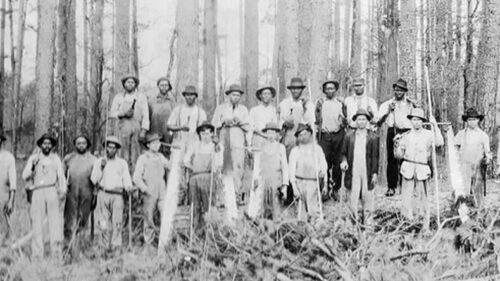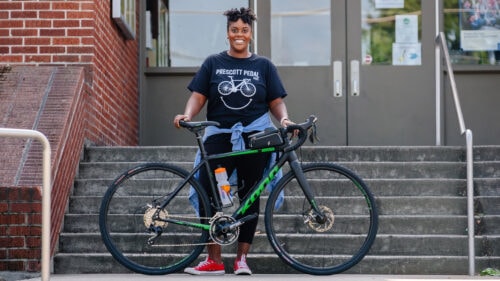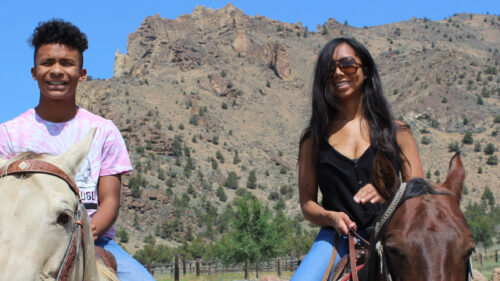Editor’s note: Read Travel Oregon’s Black Lives Matter statement.
The allure of Oregon’s sweeping coastal vistas, thick conifer forests and snowcapped peaks transcends a single demographic. But when Black travelers visit the state, they invariably wonder why there are so few Black people here. In fact, educator and historical scholar Walidah Imarisha has traveled the state for years with an informative lecture that answers the question: “Why Aren’t There More Black People in Oregon?”
The answer is rooted in the state’s three separate Black exclusion laws that were once part of the Oregon Constitution. The discriminatory language was not even completely removed from the historical document until 2001.
“Blacks had absolutely no legal standing and their very presence in Oregon was a criminal act,” Imarisha notes. “They had to do nothing other than be here to be committing a crime.”
Although the exclusions were not generally enforced, the cognitive dissonance of living in a scenic wonderland that once had one of the nation’s highest Ku Klux Klan memberships still had its intended effect: discouraging Black folks from feeling at home in one of the nation’s whitest states.
Consequently, the number of Black people in Oregon has never been substantial, and the overwhelming majority live in the Portland metro area. Currently, Oregon’s Black population is a hair more than 5.8% of the state’s 4.2 million residents.
Yet, when the timber and war industries needed black bodies to cut down trees in Eastern Oregon; build WWII battleships in Vanport, just north of Portland; or load and unload passenger luggage for the transcontinental railroad, thousands of Black families migrated here to escape state-sanctioned lynchings in the South, earn living-wage jobs and test the boundaries of racial freedom outside of Jim Crow edicts.

Truly, if there ever were a blues song created about being Black in Oregon, it would include lyrics about fitting in, sometimes fighting back, but always staking claim, despite the ground continuously shifting underneath them.
“It’s kind of unique in the sense that there really wasn’t supposed to be a Black community here, but one developed anyway,” says Kayin Talton Davis, who co-founded Soapbox Theory and Screw Loose Studio with her husband. Through her illustration work (appearing on cards, T-shirts, tote bags, pillows and more), Talton Davis seeks to increase Black representation in the arts. Her family, which has lived in the Portland area since the early 1940s, has seen the local Black community disrupted again and again.

That history of discrimination, displacement and resilience is narrated in various recurring walking tours hosted by the non-profit group Know Your City (currently on hiatus), which highlights the journey of the city’s Black residents. Tours such as the “Hidden History of Albina” illuminate the “dramatic changes [that] have altered the face of the region, something that can’t easily go unnoticed.” Visitors learn how, more than 50 years ago, the city razed hundreds of homes and businesses in North Portland, the once-historic heart of the Black community. They’ll learn the names of prominent local figures like Roslyn Hill, a developer who was called “The Queen of Alberta” for her role in the early renaissance of that northeast street, or Paul Knauls, a businessman with a magnetic personality known as the unofficial mayor of Northeast Portland. Stops on the Albina tour include the only church where Martin Luther King Jr. preached in Oregon (Vancouver Avenue Baptist Church) and one of the few remaining Black-owned businesses on North Mississippi Avenue (Sons of Haiti Masonic Lodge), showing how demographic shifts have taken their toll.
“There are so many people who have sentimental value about what once was, and losing that is hard,” says Talton Davis. “Things have changed a lot in a very, very quick manner — and you can’t just tell people to get over it.”

But even despite the historic and present-day challenges of being Black in Oregon, Portland does have homegrown and recently transplanted Black residents who have created indisputable chronicles of success. To name only a few: Deena Pierott, who was in Essence Magazine’s “50 Black Women Founders to Watch,” is the founder of Portland’s iUrban Teen, which offers STEM+Arts education programming for Black and Latino youth. Family-run Colas Construction, founded in 1997 by Haitian immigrant Hermann Colas Jr., recently was awarded a $27-million contract to spruce up the Oregon Convention Center, to welcome more visitors.
“The levels of layers and narratives are a lot broader than they used to be,” says economist and entrepreneur Stephen Green, founder of PitchBlack, an event that exposes Black-owned startups to potential funders. Within three years, the Portland participants of PitchBlack have raised almost $20 million in investments. Green has also expanded PitchBlack into Seattle; Oakland, California; and Austin, Texas.
“It’s not new,” Green adds, about the multiplicity of the black experience in Portland, “but it’s now part of the narrative — as opposed to before, when things were more monolithic.”
Portland does have homegrown and recently transplanted Black residents who have created indisputable chronicles of success.

Black residents have invested creative talent into establishing a presence of cultural offerings by and for the black community. World Arts Foundation‘s annual MLK birthday tribute at Highland Church in January, or the Good in the Hood festival at Lillis Albina Park in June are considered spontaneous “family” reunions for the Black community. Photographer-dancer-writer Intisar Abioto received international acclaim after her ongoing street-photo project, “The Black Portlanders,” opened the doors for her to wander across seven countries and three continents to, as she says, “weave a portrait of Black ubiquity through photographic image.” Abioto is the author of the “Black Portlands” zine, which was published by Travel Portland to give a platform to underrepresented voices in travel media. Black Lives Matter Portland has also launched a zine detailing their work in the Portland area, Unbroken, Black and Free, detailing their call to action, beliefs and work.
Within the last few years, new and native Portlanders have also added to the mix of annual cultural celebrations, with the additions of the Vanport Mosaic Festival (May), the Vanport Jazz Festival (August) and the Portland Black Music Festival. These Black-led gatherings complement the longstanding community-based Kwanzaa celebrations, the Black Student Success Summit and the Y.O.U.th Summit. The quarterly Say Hey! networking event, run by the Partners in Diversity business council, introduces dozens of people of color who have recently relocated.

More recurring events include Simple X Mixer, geared towards BIPOCs navigating the workplace; Here to Stay Series, a bimonthly speaker series showcasing female thought leaders; MLK Jr. Day of Service at Portland Community College – Cascade Campus. Martin Luther King Jr. Day is also a free-entrance day at National Parks. Throughout the year, Oregon Black Pioneers hosts exhibits and events across the state.
Many Black newcomers are establishing their own social networks, creative initiatives and interpretations of culture. For example, Bertony Faustin, a transplanted New Yorker, is the first recorded Black winemaker in Oregon. In 2008 he founded the 10-acre Abbey Creek Vineyard in North Plains, about 18 miles west of Portland. A handful of Black 20-somethings also started two new theater companies: Syde-Ide Collaborations, run by Monica Fleetwood and Tyharra Cozier, and Confrontation Theatre, established by actor LaTevin Alexander, who also organizes facilitated Fade to Black conversations around what it’s like to be Black in Portland.


Talton Davis and her husband use their art to visibly create a link between the present black experience and the community’s past. Thanks to a grant from the Portland Bureau of Transportation and the Regional Arts and Culture Council, the couple once installed a permanent multimedia art project: the Historic Black Williams Project, which consists of 30 mounted signs and 10 sidewalk tiles on both sides of a 2.5-mile stretch of North Williams Avenue, once the segregated and vibrant heart of Portland’s Black community. The historical photos, art and stories celebrate the black experience along the iconic street, known then as “Black Broadway” because one could regularly hear jazz greats — including Duke Ellington, Ella Fitzgerald and Louis Armstrong — in the 1940s and ’50s.
Over and over, whether it’s the tale of Black newcomers or Black trailblazers, the moral of the story about being Black in Oregon is one of resiliency, of determination and of continuously salvaging hope by mixing sweet triumphs with bitter truths of historical exclusion and displacement, then using those ingredients to bake a pie in an oven that sometimes doesn’t fully heat up — hoping that, in the end, it will still taste and smell like home.
The moral of the story about being Black in Oregon is one of resiliency, of determination and of continuously salvaging hope by mixing sweet triumphs with bitter truths.



